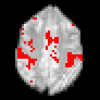Free Online Productivity Tools
i2Speak
i2Symbol
i2OCR
iTex2Img
iWeb2Print
iWeb2Shot
i2Type
iPdf2Split
iPdf2Merge
i2Bopomofo
i2Arabic
i2Style
i2Image
i2PDF
iLatex2Rtf
Sci2ools
ISBI
2008
IEEE
2008
IEEE
Controlling the error in FMRI: Hypothesis testing or set estimation?
This paper describes a new methodology and associated theoretical analysis for rapid and accurate extraction of activation regions from functional MRI data. Most fMRI data analysis methods in use today adopt a hypothesis testing approach, in which the BOLD signals in individual voxels or clusters of voxels are compared to a threshold. In order to obtain statistically meaningful results, the testing must be limited to very small numbers of voxels/clusters or the threshold must be set extremely high. Furthermore, voxelization introduces partial volume effects (PVE), which present a persistent error in the localization of activity that no testing procedure can overcome. We abandon the multiple hypothesis testing approach in this paper, and instead advocate a new approach based on set estimation. Rather then attempting to control the probability of error, our method aims to control the spatial volume of the error. To do this, we view the activation regions as level sets of the statistical...
Hypothesis Testing Approach | ISBI 2008 | Medical Imaging | Persistent Error | Smallest Error Volume |
| Added | 20 Nov 2009 |
| Updated | 20 Nov 2009 |
| Type | Conference |
| Year | 2008 |
| Where | ISBI |
| Authors | Aarti Singh, Rebecca Willett, Robert Nowak, Zachary T. Harmany |
Comments (0)

